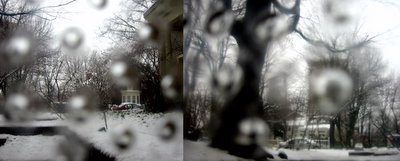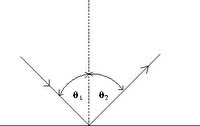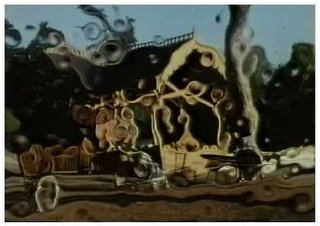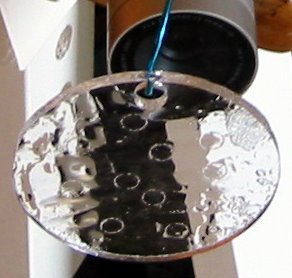If you’re new here, you may want to subscribe to my RSS feed to receive the latest Architectradure’s articles in your reader or via email. Thanks for visiting!
 The Texture of Light is research on the lighting principles for life feed video metamorphosis in public space using the reflection of light on transparent materials.
The Texture of Light is research on the lighting principles for life feed video metamorphosis in public space using the reflection of light on transparent materials.
Material Background
Research on light properties on transparent materials.
The first property of light we consider is reflection from a surface, such as that of a mirror. When light is reflected off any surface, the angle of incidence is always equal to the angle of reflection. The angles are always measured with respect to the normal to the surface. This can give us a modification in the geometry of a represented image if the normal is twisted.

I also researched on color transformation and color density of an image through transparent materials. Refraction is the bending of light as it passes between materials of different optical density. The formula of the index of Refraction of a material is the ratio of the speed of light in vacuum to the speed of light in that material: n = c/v where v is the speed of light in the material.
The more dense the material, the slower the speed of light in that material. In Texture of Light a extra piece of transparent material on top of the Plexiglas lense makes the speed of light in that material slower, then less bright. That explains the opacity of the final colors. Also the change in speed and wavelength at the boundary between two materials causes light to change direction.I have looked at the diffraction phenomena to transform light passing through transparent materials. Diffraction is the apparent “bending” of light waves around obstacles in its path.

Diffraction of waves through a slit.
This bending is due to Huygen’s principle, which states that all points along a wave front act as if they were point sources. Thus, when a wave comes against a barrier with a small opening, all but one of the effective point sources are blocked, and the light coming through the opening behaves as a single point source, so that the light emerges in all directions, instead of just passing straight through the slit.
Concept
My original idea was to transform a picture by applying different transparent sheets between the captured image and the projected final image.

Inspiring research
Dr Saul Griffith who graduated from the MIT Media Lab has reconstructed magnifying lenses using liquid plastic.

Movie presenting his implementation
This work is used by the Low Cost Eyeglasses enterprise whose goal is to design eyeglass systems that make eyeglasses inexpensive and easy to purchase.
Movie maker Patrick Bokanowski seems to have used water, oil, glass material on his movies experiments as seen in Au Bord du Lac (1993). I believe that cinema offers an interpretation, a point of view of reality. What if this point of view was due to light transformation? Bokanowski experimental cinema work has inspired me to analyze this type of imagery that presents a distortion of light and offers a possible reinterpretation of its meaning.

Screenshot of Au Bord du Lac (1993) by Patrick Bokanowski.
Experimentations with transparent materials
To instantly transform light on life feed video into the public space, I had the choice of applying mathematical formulas onto the captured digital visuals or re-discovering the direct use of light. The tangible potential of direct use of light onto Plexiglas lenses and transparent materials offers two main options that are key in this project. One is the collaboration in the public space facilitated by tangible means. The other one is the improvisation and experimentation space offered by such tangible and mechanical system.I also had to decide if I wanted to work on still or moving visual captures. I have realized that transforming a still image is not as powerful as the moving image metamorphosis. One can easily recompose the still image by understanding its light distortions. However, by applying lighting principles on a moving image, the mental re-composition is difficult thus the re-interpretation of the unknown is very fascinating. The reality becomes a painting, a moving painting.
A series of experiments with transparent materials allows me to analyze video metamorphosis. During these experiments, I have used water on clear plastic, shower gel, polyoptic 1410 clear plastic, crystal clear flex: clear flexible, material that melts on high temperature and dries quickly within average temperature.
The following are screenshots of videos documenting a selection of material tests.
A drop of water onto a clear rigid plastic sheet

The video camera is still, the drop of water is moving
Transparent shower gel onto a clear rigid plastic sheet

The video camera is still, the rigid clear plastic sheet moves, the shower gel stays still
Transparent shower gel onto a clear rigid plastic sheet

The video camera moves with the rigid clear plastic sheet
Polyoptic 1410 clear plastic onto a clear rigid plastic sheet

The video camera moves with the rigid clear plastic sheet
Results
The shower gel has a life on its own: moves, changes texture & density over time. This particularity allows more irregularity in the transformed image thus the final transformed image resembles a painting. Also, the mapping between the original image and its final transformation is harder to perceive. This allows more attempts in interpreting the visuals.The material that melts on high temperature and dries under an average temperature can be sculpted easily and used as silicon. However as it dries, the density of the material is so high that it is difficult to see through.The clear plastic on the other hand is more difficult to sculpt and does not allow much improvisation after being fabricated. To allow more control over light transformation, I have decided to use clear plastic molds and Plexiglas lenses. I have used Crystal Clear & Clear Flex for the patterns and lenses. I used transparent Plexiglas for the structure of the lenses.
Design of the lenses
Laser cut Plexiglas lenses as clear plastic molds
I have designed different lenses sizes, each with different pattern shapes and pattern sizes. In addition, I have used flat lenses on which I have created clear plastic patterns, e.g. drops of clear plastic, rows of lines.

Regular patterns laser cut into transparent Plexiglas

After many chemical attempts, final choice: Crystal Clear & Clear Flex

Plexiglas lenses filled with Crystal Clear & Clear Flex mix (1A:2B)

Lense with irregular patterns positioned at 2cm from the video camera
This is the research conducted to create my final project: The Texture of Lightfor the Smart Materials course taught by Michelle Addington
Paper about the project (12mb)
More links
Very interesting related research Gate Vision, found on we-make-money-not-art (blog that is part of the best european ones). The results of this project are kaleidoscopics and the mechanism is digital rather than mechanical.
I particularly liked the circular metaphor of the visuals and reminded me of one of my favorite experimental movie Lapis by James Whitney (1966)an abstract art film composed of images produced by an analog computer.






























